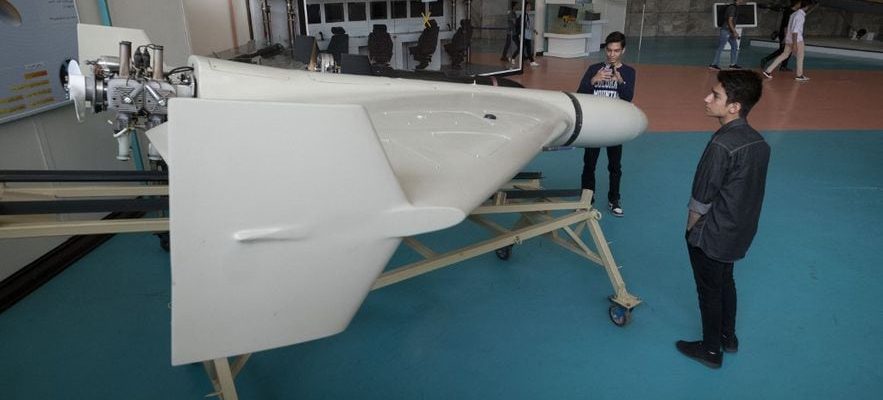On January 2, a wave of missiles struck Kharkiv, Ukraine’s second largest city, gutting several buildings in the center and killing three people. The Ukrainian authorities quickly made the accusation: not all of the projectiles used came from Russia. “This missile is similar to one of those from North Korea,” denounced, on January 6, Dmytro Chubenko, spokesperson for the Kharkiv prosecutor’s office, in front of the charred carcass of one of the devices, echoing the accusations made two days earlier by Washington.
“Our information indicates that North Korea recently provided Russia with ballistic missile launch systems and several missiles,” said the spokesperson for the American National Security Council, John Kirby, on January 4, specifying that they had been used on December 30 and January 2. Still according to the White House, Russia also plans to buy missiles from Iran.
“Both Russia and Ukraine are today faced with a problem of progressive exhaustion of their military resources,” points out Thibault Fouillet, scientific director of the Institute of Strategy and Defense Studies at the University of Lyon III. two countries need to diversify their sources of supply, and aid international cooperation plays a crucial role.” Pyongyang and Tehran are today the main foreign sponsors of the Russian war effort in Ukraine.
Rification with Pyongyang
If the North Korean missile models in question – with an estimated range of 900 kilometers – have not been officially revealed by Washington, several experts believe that they are the KN-23, KN-24 or KN- 25. “These short-range ballistic missiles are credible hypotheses,” confirms Ankit Panda, researcher at the Carnegie Endowment for International Peace in Washington. “They are slightly larger than the Iskander-M, an analogous model used by the Russian army.”
The aid provided by Pyongyang does not stop there. After a meeting between Vladimir Putin and Kim Jong-un in the Russian Far East in September, the United States had already reported in October the transfer to Russia of more than 1,000 containers of military equipment from North Korea . Then, at the beginning of November, a South Korean MP, citing his country’s intelligence services, reported a delivery of more than 1 million North Korean shells to the Russian army.
This welcome contribution for the Russian forces also constitutes a symbolic snub for the Europeans, who, despite their promise to deliver 1 million shells to Kiev by next March, recognized in November that the objective could not be achieved. reached due to lack of sufficient production capacity. “North Korean shell stocks are vast and could allow Pyongyang to continue supplying Russia, if it considers it can afford it in view of its own needs,” adds Ankit Panda.
“Saturating Ukrainian anti-aircraft defenses”
Before turning to North Korea, Moscow also began using Iranian-made Shahed kamikaze drones in September 2022. Inexpensive – between $20,000 and $50,000 per unit – they have been used en masse since then to target Ukrainian infrastructure. “The Russians’ objective is to saturate Ukrainian anti-aircraft defenses, and to push kyiv to spend expensive munitions on low-value targets,” underlines General Nicolas Richoux, former commander of the 7th Armored Brigade.
An Iranian Shahed-136 drone, displayed in the National Aerospace Park of the Islamic Revolutionary Guard Corps, in Tehran, October 11, 2023.
© / NurPhoto via AFP
“We are sorely missing [de systèmes de défense antiaérienne], lamented Volodymyr Zelensky on January 10, during a trip to Lithuania. In recent days, Russia has struck Ukraine with a total of 500 devices [missiles et drones]we destroyed 70%.” Since 2022, more than 3,700 Shaheds have been fired, Kiev estimated at the end of December. At the same time, the Islamic Republic also assisted Moscow in the construction of its own drone manufacturing factory, in the Yelabuga region, some 1,000 kilometers from the Russian capital.
Elevator return
In Pyongyang as in Tehran – both under heavy international sanctions – this support is not without ulterior motives. “Iran is looking for Russian weapons,” says General Richoux. “Its military apparatus has been frozen for decades.” At the end of November, the Iranian Deputy Minister of Defense indicated that an agreement had been finalized with Moscow for the delivery of Sukhoi Su-35 combat aircraft, Mil Mi-28 attack helicopters and aircraft Russian-made Yak-130 trainer.
Similarly, South Korean intelligence claimed that Russia helped Pyongyang launch its first spy satellite in November – after two unsuccessful attempts. “North Korea perceives that it has much to gain from courting Russia: political support, technical assistance in space and military matters, cooperation in the supply of raw materials and, potentially also, food aid, list Ankit Panda, of the Carnegie Center. Pyongyang could also have an interest in observing how its missiles behave in an air defense environment contested by Western systems.
More discreetly, and despite Beijing’s denials, China would also provide “dual-use” equipment used by Moscow to continue its war in Ukraine, Washington said in July. Equipment including “navigation equipment, jamming technologies and combat aircraft parts”, according to a report of American intelligence.
At a time when Western assistance to Ukraine seems to be stalling, can this foreign support received by Moscow reverse the trend? In Germany, the debate over the delivery of Taurus cruise missiles – with a range of 500 kilometers – has intensified in recent days after the increase in Russian bombings. “The delivery of Taurus missiles to Ukraine should have taken place a long time ago,” said Sara Nanni, spokesperson for the Greens parliamentary group, a member party of Olaf Scholz’s coalition government, on January 6. In October, the German chancellor refused to deliver them, for fear that they could be used against Russian territory. Pyongyang and Tehran had fewer qualms.
.
